Grace Robert. Advanced Blowout and Well Control
Подождите немного. Документ загружается.

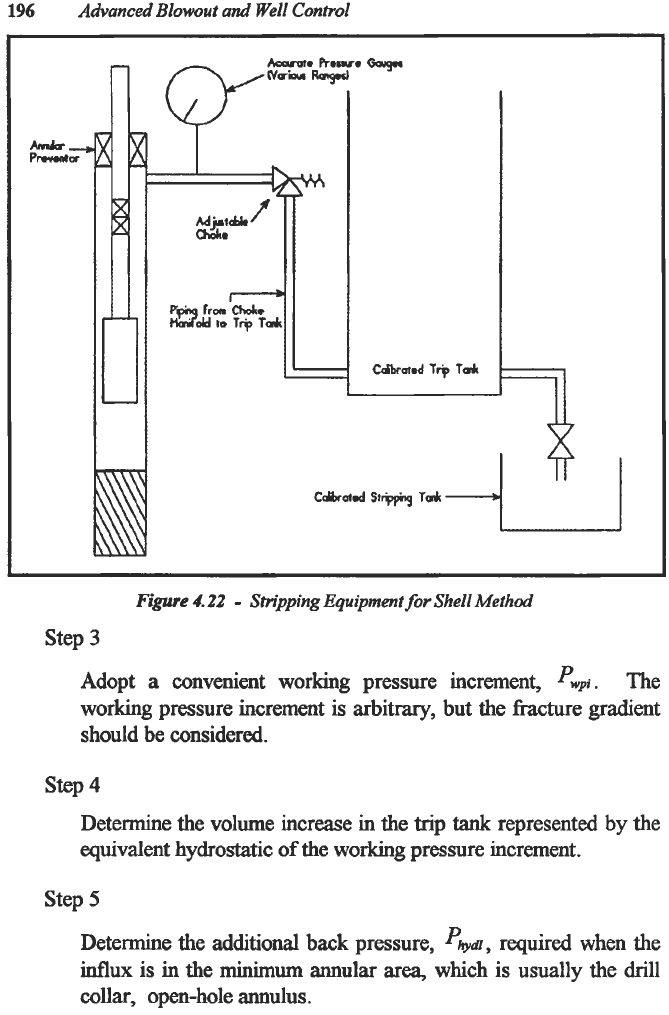
196
Advanced
Blowout
and
Well
Control
knbr
PmWr
Y
figure
4.22
-
Stnpping
Equi’ent
for
Shell
Method
Step
3
Adopt
a
convenient working pressure increment,
pwpi.
The
working pressure increment
is
arbitrary, but the fracture gradient
should
be
considered.
Determine the volume increase
in
the
trip
tank
represented by the
equivalent hydrostatic
of
the working pressure increment.
step
5
Determine the
additional
back
pressure,
pw,
required
when the
influx
is
in
the
minimum
annular
area,
which
is
usually
the
drill
collar,
open-hole annulus.
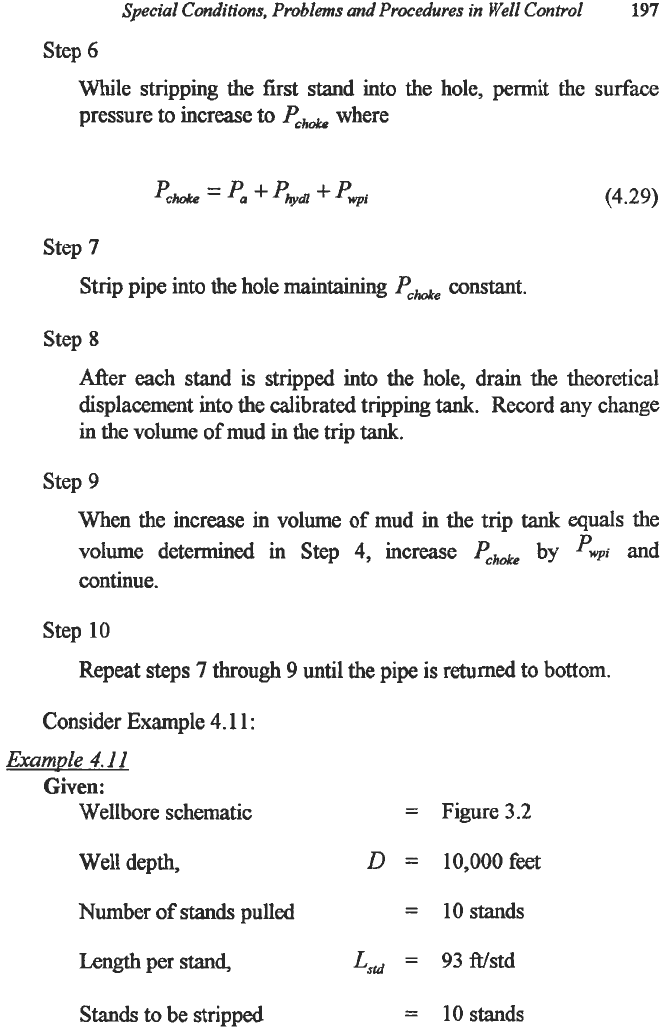
Special Conditions, Problems and Procedures
in
Well Control
197
Step
6
While stripping the
first
stand into the hole, permit the
surface
pressure to increase to
e,,&
where
(4.29)
step
7
Strip pipe into the hole maintaining
ewe
constant.
Step
8
After each stand
is
stripped into the hole, drain the theoretical
displacement into the calibrated tripping
tank.
Record
any
change
in the volume
of
mud in the trip
tank.
Step
9
When the increase in volume
of
mud in the trip
tank
equals
the
volume determined in Step
4,
increase
pchoko
by ‘wpi and
continue.
Step
10
Repeat steps
7
through
9
until
the
pipe is returned to
bottom.
Consider Example
4.1
1
:
Example
4.11
Given:
Wellbore schematic
Well depth,
Number
of
stands
pulled
Length per
stand,
Stands to be stripped
=
Figure 3.2
D
=
10,000
feet
=
10
stands
Lsrd
=
93
Wstd
=
10
stands
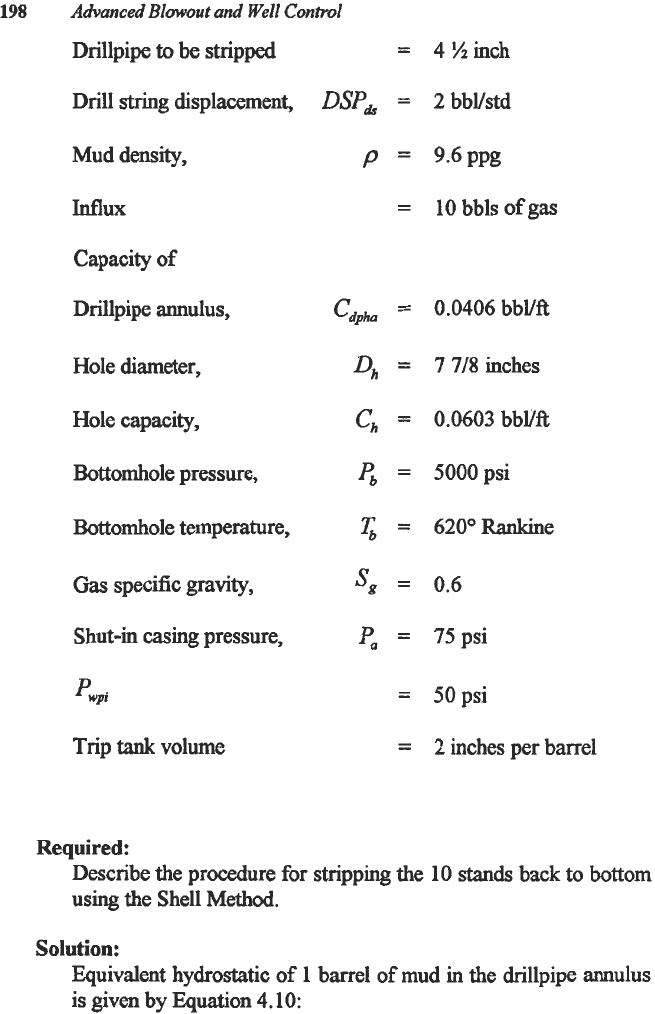
198
Advanced
Blowout
and Well
Control
Drillpipe
to
be stripped
Drill string displacement,
Mud density,
Influx
Capacity of
Drillpipe annulus,
Hole diameter,
Hole capacity,
Bottomhole pressure,
Bottomhole temperature,
Gas
specific gravity,
Shut-in casing pressure,
Pwpi
Trip
tank
volume
=
4'/inch
DSP,
=
2bbVstd
P
=
9.6PPg
=
1Obblsofgas
0.0406 bbVft
7
718
inches
0.0603
bbVft
5000
psi
620°
Rankine
0.6
75
psi
50
psi
2
inches per barrel
Required:
Describe the procedure for stripping the 10
stands
back
to
bottom
using the Shell Method.
So
I
u
t
i
o
n
:
Equivalent hydrostatic of 1 barrel of mud
in
the drillpipe annulus
is given by
Equation
4.10:
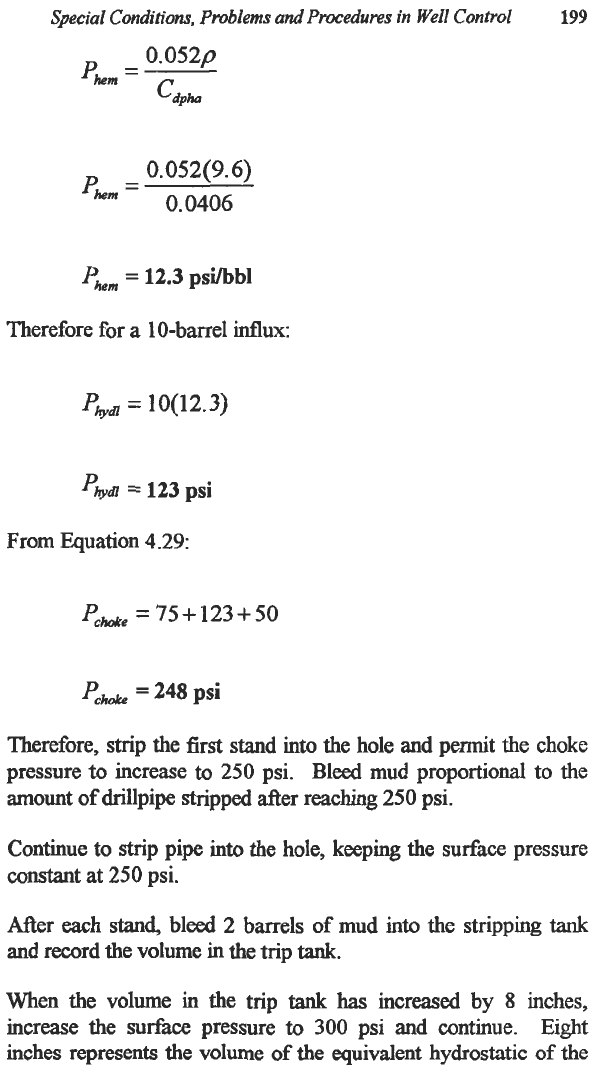
Special Conditions, Problems and Procedures
in
Well
Control
199
0.052~
Pkln
=
Cdpho
0.052(9.6)
0.0406
‘kern
=
4ern
=
12.3
psi/bbl
Therefore for
a
10-barrel
influx:
Pbd
=
lO(12.3)
pbd
=
123
psi
From Equation
4.29:
eMe
=
75+123+50
Pchh
=
248
psi
Therefore, strip the first stand into the hole and permit the choke
pressure
to
increase
to
250
psi. Bleed mud proportional to the
amount
of
drillpipe stripped after reaching
250
psi.
Continue to strip pipe into the hole, keeping the surface pressure
constant
at
250
psi.
After
each
stand,
bleed
2
barrels of mud into
the
stripping
tank
and record the volume in the trip
tank.
When
the volume in the trip
tank
has
increased by 8 inches,
increase the surfice pressure
to
300
psi and continue. Eight
inches represents the volume
of
the equivalent hydrostatic
of
the
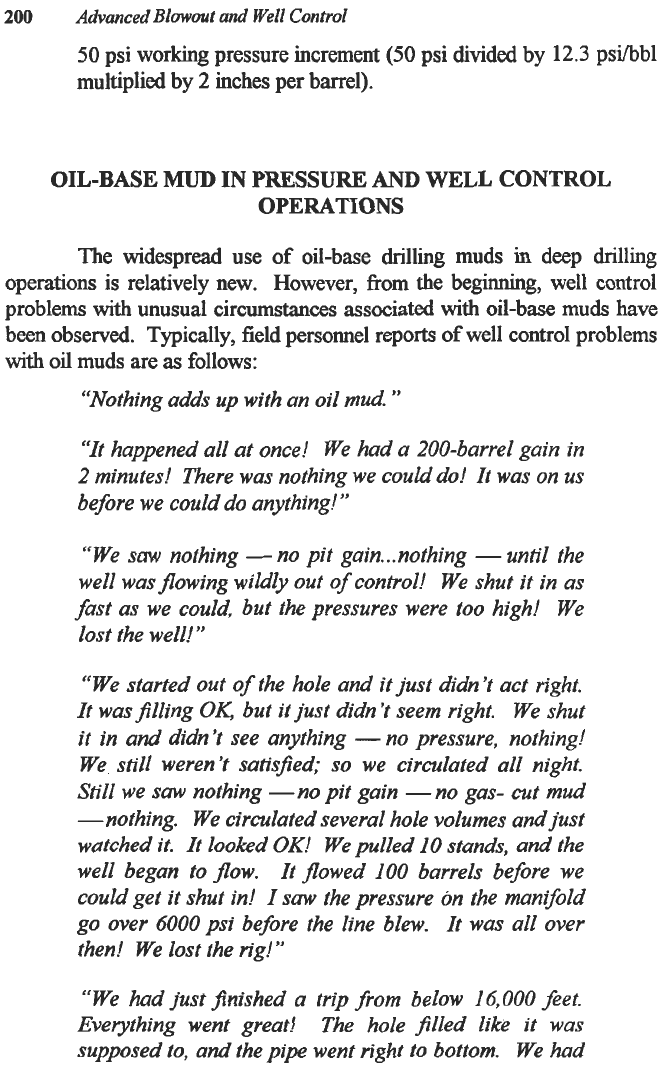
200
Advanced
Blowout
and
Well
Control
50
psi working pressure increment
(50
psi divided by 12.3 psihbl
multiplied by
2
inches per barrel).
OIL-BASE
MUD
IN PRESSURE
AND
WELL CONTROL
OPERATIONS
The widespread use of oil-base drilling muds in deep drilling
operations is relatively new. However, from the beginning, well control
problems with unusual circumstances associated with oil-base muds have
been observed. Typically, field personnel reports
of
well control problems
with
oil
muds are
as
follows:
“Nothing adds up with an oil mud.
Yt
happened all at once!
We had a 200-barrel gain in
2 minutes! There was nothing we could do! It was on
us
before
we
could
do
anything!
”
“We
saw
nothing
-
no pit gain
...
nothing
-
until
the
well was frowing wildly out of control! We shut
it
in as
fast as we could, but the pressures were too high! We
lost the well!
”
“We started out
of
the hole and
it
just didn ’t act right.
It wasjlling
OK,
but
it
just didn ’t seem right. We shut
it in and didn’t see anything
-
no pressure, nothing!
We still weren’t satisjed;
so
we
circulated all night.
Still
we
saw
nothing -no pit gain
-
no gas- cut mud
-nothing, We circulated several hole volumes and just
watched it. It looked
OK!
We pulled
10
stands,
ana‘
the
well began to frow. It jlowed
100
barrels before we
could get it shut in! I
saw
the pressure on the manifold
go
over 6000psi before the line blew. It was all over
then! We lost the rig!”
“We had just jnished a trip from below
16,000
feet.
Everything went great! The hole filled like it was
supposed to, ana‘ the pipe went right to bottom. We had
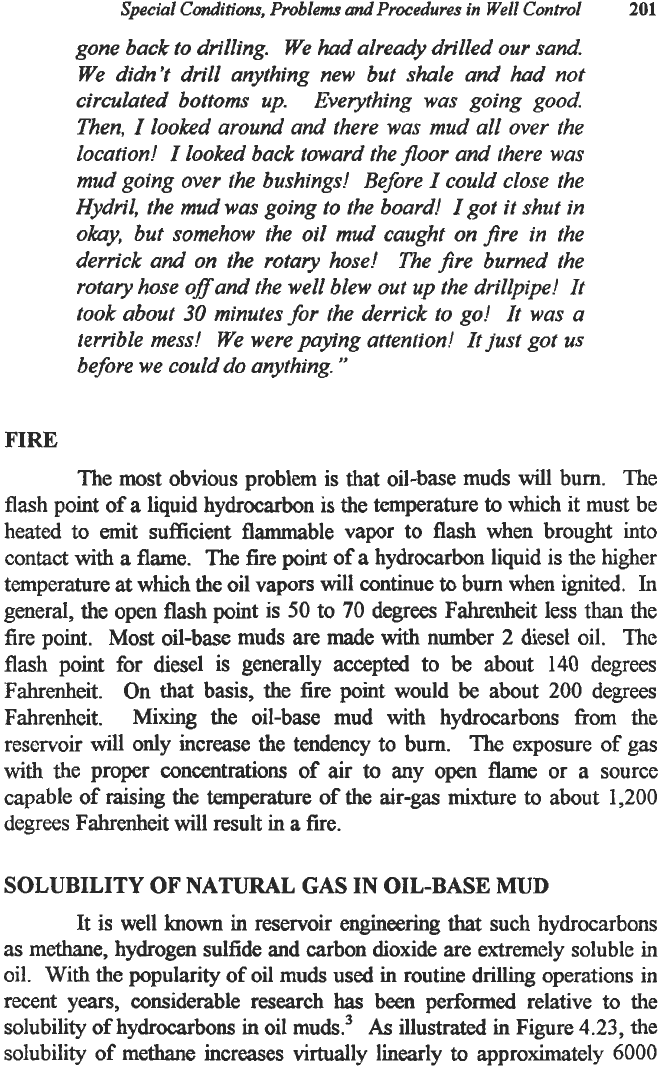
Special
Conditions,
Pmblems
and
Procedures
in
Well Control
gone back to drilling. We had already drilled our sand.
We didn’t drill anything new but shale and had not
circulated bottoms up. Everything was going good.
Then, I looked around and there was mud all over the
location!
I
looked back toward the jloor and there was
mud going over the bushings! Before I could close the
Hydril, the mud was going to the board! I got
it
shut in
okay, but somehow the
oil
mud caught on jre in the
derrick and on the rotary hose! The jre burned the
rotary hose ofland the well blew out up the drillpipe! It
took about
30
minutes
for
the derrick to go! It was a
terrible mess! We were paying attention! It just got
us
before we could do anything.”
201
FIRE
The most obvious problem is that oil-base muds will bum. The
flash point
of
a
liquid hydrocarbon is the temperature
to
which it must be
heated to
emit
sufficient flammable vapor to flash when brought into
contact with
a
flame. The fire point of
a
hydrocarbon liquid is the higher
temperature
at
which the oil vapors will continue
to
bum when ignited. In
general, the open flash point is
50
to
70
degrees
Fahrenheit less than
the
fire point.
Most oil-base muds are made with number
2
diesel oil.
The
flash point for diesel is generally accepted to
be
about 140 degrees
Fahrenheit. On that basis, the fire point would
be
about
200
degrees
Fahrenhcit. Mixing the oil-base mud with hydrocarbons fiom the
reservoir will only increase the tendency to bum. The exposure
of
gas
with the proper concentrations
of
air
to
any open flame or
a
source
capable
of
raising the temperature of the air-gas mixture
to
about
1,200
degrees Fahrenheit will result in a fire.
SOLUBILITY
OF
NATURAL GAS IN OIL-BASE
MUD
It is well
known
in reservoir
engineering
that
such hydrocarbons
as methane, hydrogen sulfide and carbon dioxide are extremely soluble in
oil. With the popularity
of
oil muds used in routine drilling operations in
recent years, considerable research
has
been performed relative to the
solubility
of
hydrocarbons in oil muds.3
As
illustrated in Figure
4.23,
the
solubility
of
methane increases virtually linearly
to
approximately
6000
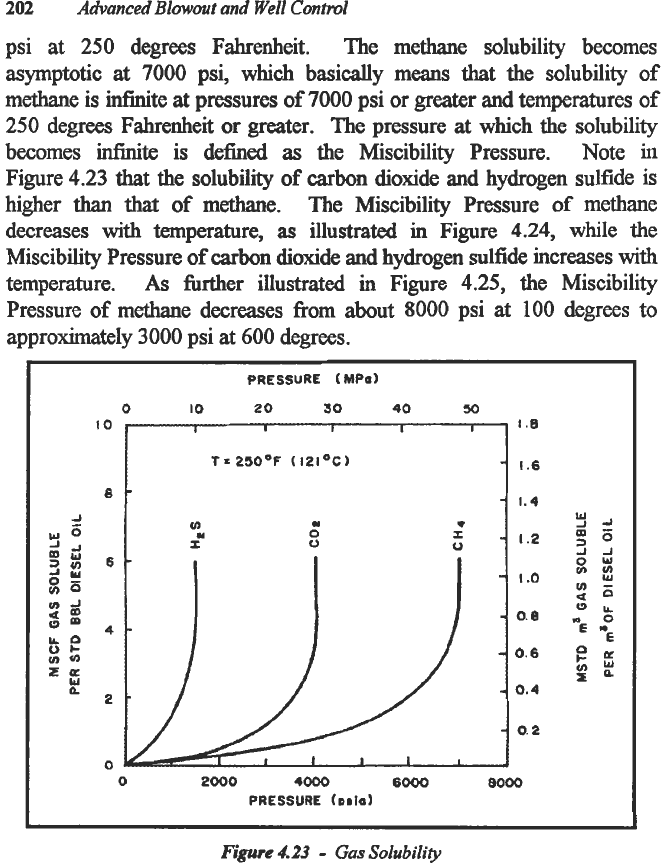
202
psi at
250
degrees Fahrenheit. The methane solubility becomes
asymptotic
at
7000
psi, which basically means
that
the solubility
of
methane is infinite at pressures
of
7000
psi or greater and temperatures
of
250
degrees Fahrenheit or greater. The pressure
at
which the solubility
becomes infinite is
defined
as
the Miscibility Pressure. Note
in
Figure
4.23
that
the solubility
of
carbon
dioxide and hydrogen sulfide is
higher
than
that
of methane. The Miscibility Pressure
of
methane
decreases with temperature,
as
illustrated
in
Figure
4.24,
while the
Miscibility Pressure
of
carbon
dioxide and hydrogen sulfide increases with
temperature.
As fbrther illustrated
in
Figure
4.25,
the Miscibility
Pressure
of methane decreases from abut
8000
psi at
100
degrees to
approximately
3000
psi at
600
degrees.
Advanced
Blowout
and Well
Control
PRESSURE
(
MPd
0
IO
20
50
40
50
lo
f
I'B
-
1.6
I.
4
-
1.2
1.0
-
-
-
0.e
-
0.6
-
0.4
-
0.2
0
2000
4Ooo
6000
PRESSURE
(nnia)
I
Figure
4.23
-
Gas
Solubiliiy
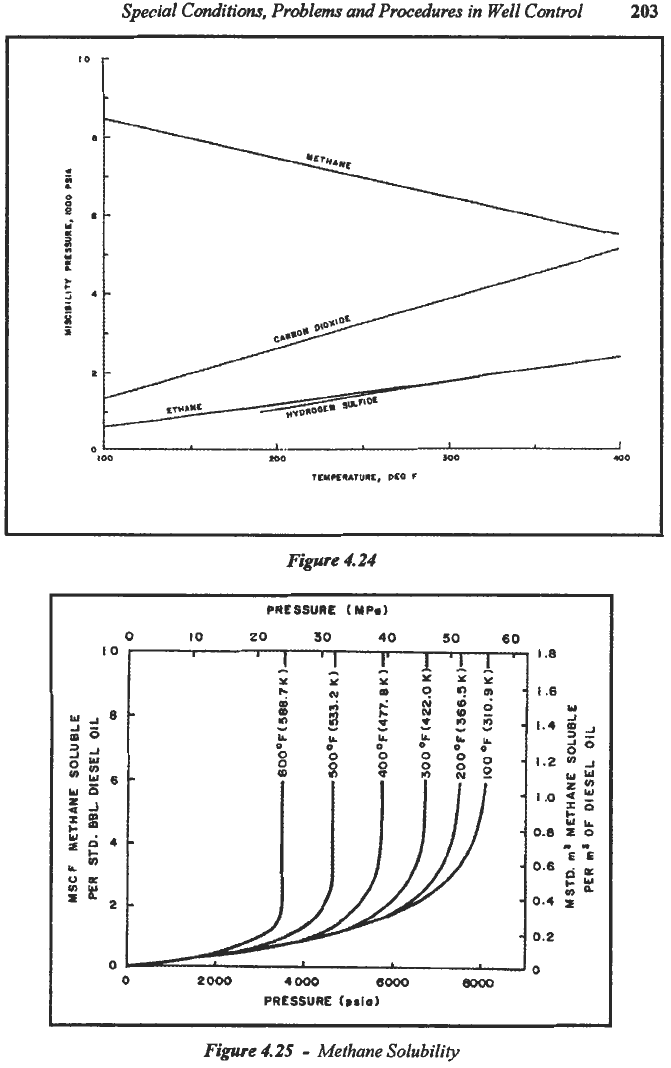
Special
Conditions. Problems
and
Procedures in
Well
Control
203
.-
I
I
100
tDD
300
40
TEYPERhlUIC,
DCO
f
Figure
4.24
I
PRESSURE
(YP.1
I
Figure
4.25
-
Methane
Solubility
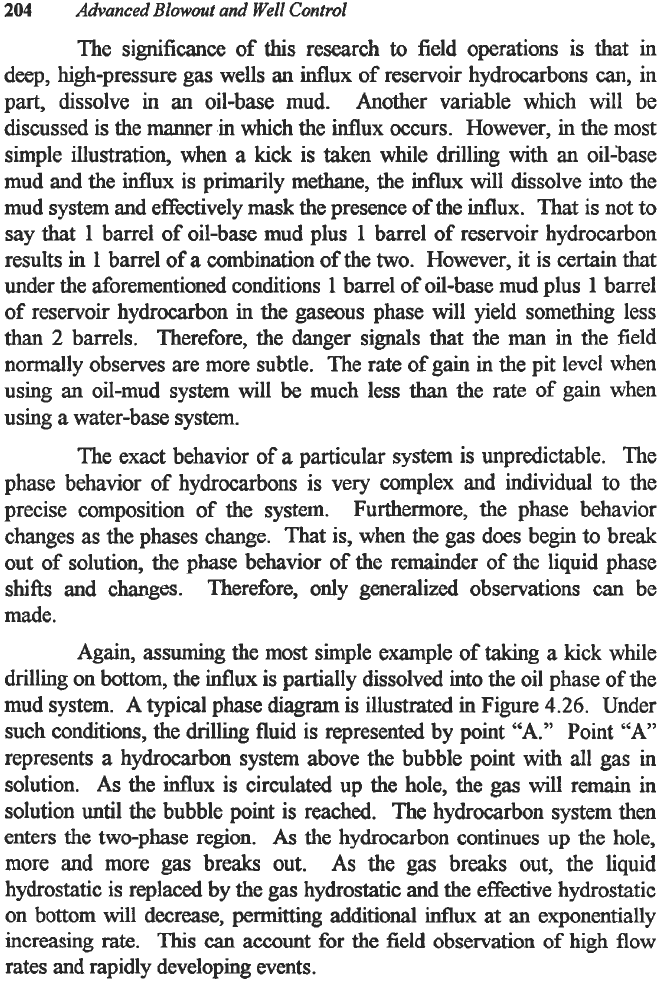
204
Advanced
Blowout
and Well
Control
The significance
of
this
research
to
field operations is that in
deep, high-pressure gas wells an influx
of
reservoir hydrocarbons
can,
in
part, dissolve in an oil-base mud. Another variable which will be
discussed is the manner in which the influx occurs. However, in the most
simple illustration, when
a
kick
is
taken while drilling
with
an oil-base
mud and the
influx
is primarily methane, the
influx
will dissolve into the
mud system and effectively mask the presence
of
the influx. That is not to
say that 1 barrel of oil-base mud plus 1 barrel of reservoir hydrocarbon
results in
1
barrel of
a
combination
of
the
two.
However, it is certain that
under the aforementioned conditions 1 barrel of oil-base mud plus
1
barrel
of reservoir hydrocarbon in the gaseous phase will yield something less
than
2
barrels. Therefore, the danger signals that the
man
in the field
normally observes are more subtle. The rate of gain in the pit level when
using an oil-mud system will
be
much less than the rate
of
gain when
using
a
water-base system.
The exact behavior
of
a
particular system is unpredictable. The
phase behavior
of
hydrocarbons is very complex and individual to the
precise composition of the system. Furthermore, the phase behavior
changes as the phases change.
That
is, when the gas does begin to break
out
of
solution, the phase behavior of the remainder
of
the liquid phase
shifts
and changes. Therefore, only generalized observations
can
be
made.
Again, assuming the most simple example
of
taking
a
kick while
drilling on bottom, the influx
is
partially dissolved into the oil phase
of
the
mud system.
A
typical phase
diagram
is illustrated in Figure
4.26.
Under
such conditions, the drilling fluid is represented by point “A.” Point
“A”
represents
a
hydrocarbon system above the bubble point with all gas in
solution.
As
the influx is circulated up the hole, the gas will remain in
solution
until
the bubble point is reached. The hydrocarbon system then
enters the two-phase region.
As
the hydrocarbon continues up the hole,
more and more gas breaks out. As the gas breaks out, the liquid
hydrostatic is replaced by the gas hydrostatic and the effective hydrostatic
on bottom will decrease,
permitting
additional influx
at
an exponentially
increasing rate.
This
can
accounf
for the field observation
of
high flow
rates and rapidly developing events.
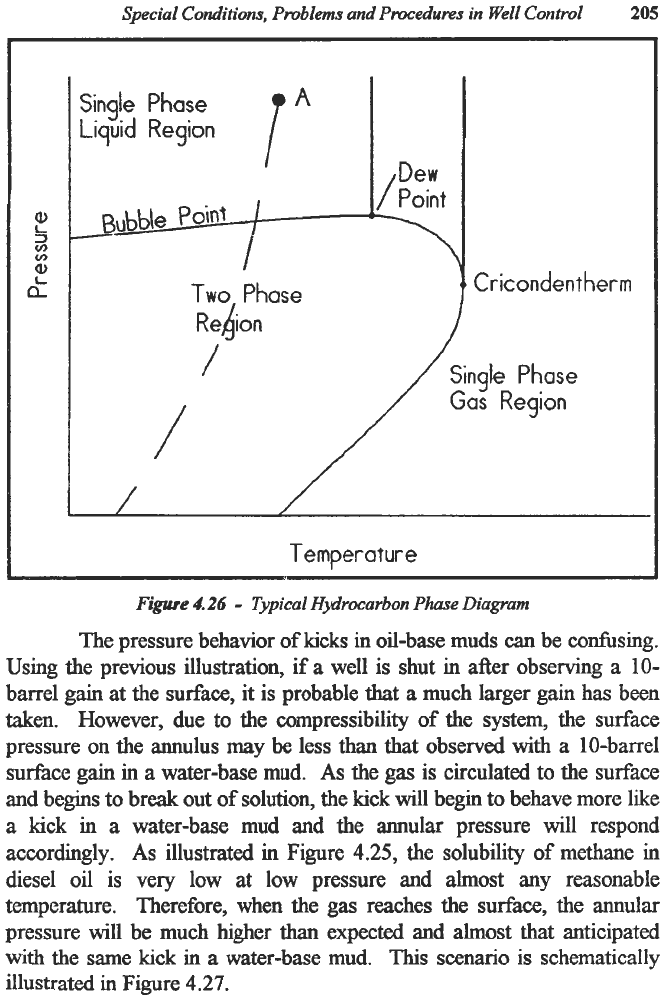
Special Conditions, Pmblems and Procedures in Well Control
205
TA
Single
Phase
iquid
Region
Two
Phase
Redion
/
Dew
/Point
\
Cr
iconden
t
her
m
Sinale
Phase
Temperature
Figure
4.26
-
Typical Hydrocarbon Phase Diagram
The pressure behavior of kicks in oil-base muds
can
be
confusing.
Using the previous illustration, if a well is shut
in
after observing a
10-
barrel gain at the surface, it is probable that
a
much larger gain has been
taken. However, due to the compressibility of the system, the surface
pressure on the annulus
may
be
less than that observed with a 10-barrel
surfkce
gain
in
a water-base mud.
As
the gas is circulated to the surface
and begins to break out
of
solution, the kick will begin to behave more like
a
kick in
a
water-base mud and the annular pressure will rcspond
accordingly.
As
illustrated
in
Figure
4.25,
the solubility of methane in
diesel oil
is
very low at low pressure and almost any reasonable
temperature. Therefore, when the
gas
reaches the surface, the annular
pressure will be much higher
than
expected and almost that anticipated
with the same kick
in
a
water-base mud.
This
scenario
is schematically
illustrated in Figure
4.27.
